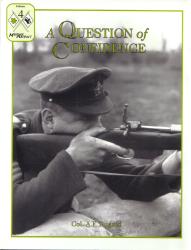| Mauser
Military Rifle Markings
by Terence W. Lapin Hyrax Publishers, LLC, 2000, softcover 139 pages ISBN 0-9676896-1-9 |
 |
|
|
|
|
presents
Book Review,
February 2001:
| Mauser
Military Rifle Markings
by Terence W. Lapin Hyrax Publishers, LLC, 2000, softcover 139 pages ISBN 0-9676896-1-9 |
 |
In 1938, the Canadian Army's Historical Section, under the command of Colonel A.F. Duguid, published the first of what was intended to be a series of volumes entitled The Official History of the Canadian Forces in the Great War; 1914 - 1919. Concurrent with the publication of the Official History was that of a companion volume of appendices, most of which were original source material. One appendix, number 111, was a monograph assembled by the Historical Section during the 1920's and 1930's, and based on original source material and army records. It was titled The Ross Rifle, Monograph, and represented the first attempt at presenting the Ross story. It is a thorough and comprehensive document that traces the Ross' history from its origins prior to the Boer War through its withdrawal from service with the Canadian Army in 1916, to the nationalization of the Ross factory. Service Publications of Ottawa, Ontario has reproduced Colonel Duguid's monograph on the Ross in its entirety in the work entitled A Question of Confidence - The Ross Rifle in the Trenches.
Service Publications has greatly benefited the firearms historian by offering this document. The original monograph has been meticulously edited and amplified with relevant photographs and carefully constructed tables that serve to clarify and augment the text. While comprehensively detailing the rifle's introduction, use and withdrawal from Canadian service, Duguid's monograph offers additional insight of a different nature. Specifically, the reader is immersed into the murky world of early twentieth century military procurement. Personalities, national pride, profit, graft, as well as an honest desire to put the best rifle possible into the hands of combat troops all played a role in the Ross rifle's development and procurement. Duguid doesn't fail to offer conclusions and judgments, indicating who the Canadian arms establishment perceived as blameworthy for what. An example of the monograph's "politically incorrect" tone:
Lieut.-Colonel F.O.W. Loomis of the 13th Battalion was more specific; "after firing 15 to 30 rounds rapid fire, the rifles jam. To loosen the bolt it was necessary to use the boot heel or the handle of an entrenching tool. The men have lost confidence in the Ross rifle as a service arm." Another commander strongly objected to taking his men into action unless the jamming was rectified, and still another respectfully submitted that "it is nothing short of murder to send our men against the enemy with such a weapon."This unique glimpse into a world seldom exposed to the historian makes the book easily worth its $15.00 US ($22.95 Canadian) price.
In addition to the political and
procurement information offered, A Question of Confidence provides
enough technical data about the Ross' design and infamous lack of reliability
under combat conditions to satisfy even the most mechanically oriented
firearms historian. With respect to the rifle's shortcomings, the
data provided are the results of the official Canadian investigation into
the rifle.
Detractors may be tempted to dismiss
A
Question of Confidence as a mere reprint of a government document.
Doing so would be a serious underestimation of the effort that has gone
into producing this volume. In addition to the thorough and painstaking
archival research, the appended photography, tables and editing are works
of the first order. The combination of the original source material,
careful editing, and well considered amplification produces a work that
is truly more than the sum of its parts.
A Question of Confidence offers
a detailed, comprehensive look into the technical and political history
behind one of the 20th century's most controversial military arms.
Moreover, it offers the collector and enthusiast access to official records
and information that were previously difficult if not impossible to find.
Between what the book offers and its bargain price (approximately $15.00
US), this is one gun book that it is difficult to justify NOT buying!
A Question
of Confidence
is available from Service
Publications. Click on the image to order:
